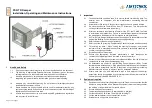
Page 9 of 11 pages
20 Routine Inspection, Testing and Maintenance
20.1
In accordance with BS 9999 Annex W.1, inspection should be undertake annually.
Local regulations/conditions may override this with periodic Inspection being
carried out more frequently where corrosive or dirty conditions prevail. The
maintenance log should be reviewed at each inspection and the frequency
adjusted as required dependent upon findings. (BSB recommend a maximum of
1 year between inspections and to start more frequently initially, and reduce
frequencies only if conditions are proven to allow).
20.2
For actuators fitted with a thermal fuse), check TF is correctly fitted to duct (Refer
to section 14)
20.3
Where a thermal fuse is present, the LED on the thermal fuse will be illuminated
when the actuator is powered. Refer to Section 21.1, if it is not illuminated.
20.4
Remove access door to reveal damper’s internal elements.
20.5
Visually inspect the internal damper elements for signs of corrosion, obstruction
or accumulated dirt/dust.
20.6
If there are any obstructions or if the damper
’s blades/gasket seals are dirty, they
need to be cleaned. It is recommended to remove the actuator before cleaning
the internal elements to avoid trapping your fingers. (Refer to section 19)
20.7
Visually check that the
damper is in its ‘powered state’ (opposite to fail-safe
position). If the
damper is not in its ‘powered state’, refer to fault finding chart,
otherwise continue.
20.8
Temporarily remove electrical power to the actuator (either by using the toggle
switch on the thermal fuse (TF actuator), or by isolating power to actuators without
a thermal fuse)
20.9
The actuator should reach its SPRING-END (fail-safe position) in <30 seconds.
Confirm visually that the blade position and indication pointer on the actuator
corresponds.
20.10 Release the TF toggle (TF) or Turn power back on to the actuator (NTF)and
ensure it reaches its DRIVE END in <60 seconds. Confirm visually that blade
position and indication pointer on the actuator corresponds.
20.11 If the damper has seized (failing to reach either drive end or spring end):-
20.11.1 Isolate and remove actuator. (Refer to section 19)
20.11.2 Spray a light lubricant into blade end bearings through the holes
on the side gaskets.
20.11.3 Using the 12mm A/F spanner on the TD box Drive Shaft, begin to
progressively operate the blades manually.
20.11.4 Open the damper using a 12mm A/F spanner on the TD box.
Check for foreign items in and around blades, paying particular
attention to blade fishtails. Remove any obstructions.
20.11.5
Clean the inside of the damper case where the blades make contact with the
gasket seals. Use a soft cloth with a light application of light lubricant. (Connect
Duck Oil recommended)
20.11.6
Lightly apply a light lubricant into blade axle bearings depressing the side gaskets
to allow access. It may be necessary to re-apply lubricant a couple of times, whilst
operating the damper using the 12mm A/F spanner, until the torque has reduced
to less than 5Nm for mid-range travel, and 10Nm for full damper closure.
20.11.17 There should be no more than a thin film of lubricant applied. Remove all excess
lubricant. It is particularly important as excess oil will tend to collect dirt and dust
which will have a negative effect on dampers remaining clean.
20.11.7
Refit the actuator (Refer to sections 15 or 16).
20.11.8
Switch on power to the actuator.
20.11.9
The actuator should reach its ‘powered state’ position in <60 seconds. If it does
not, refer to section 21.
20.11.10
Replace access doors, and ensure the damper is left in its ‘powered state’.
20.11.11 Record all work that has been undertaken in the maintenance log.
20.11.12 It is important to log and review maintenance frequency based on
inspections and test history.
20.11.13 It is important to log and review maintenance frequency based on inspections and
test history.
The use of heavy oil is not recommended, as this can lead to a build-up of dust/dirt
on damper surfaces.
20.11.14 The actuator is maintenance-free.
















